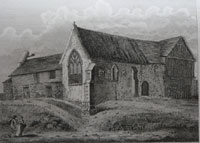
St Petronilla's Hospital
|
Our Religious Hospitals
and Schools
|
The Hospitals
|
By the time of the Dissolution of the Monasteries the various religious orders in this country had set up as many as 1,000 hospitals, almhouses, hospices for lepers, and hostels for travellers. These were vital to the social fabric of the period and the poor particularly suffered when they were closed at Dissolution.
These included the six hospitals of Bury St Edmunds. These were run independently of the abbey so far as their endowments and incomes were concerned. Most of them had been extensively endowed with lands to such an extent that in the 1295 rental we see that the Wardens of St Nicholas and St Saviour hospitals were second only to the sacrist in their property holdings in the borough. Along with St Peter's and St Petranilla's they were among the largest holders in the suburbs as well. They were exempt from the municipal tithes.
THese were of regional importance and Bury became an important centre of medicine because of the presence of these hospitals.
The six Bury Hospitals were:-
- St Saviour's Hospital, Fornham Road, Bury St Edmunds
|
|
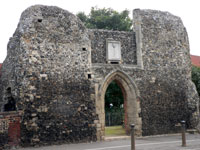 St Saviour's Hospital
St Saviour's Hospital |
This was the richest and best known of Bury Hospitals.
Abbot Samson seems to have founded this hospital about the year 1184 according to Yates. In 1186 the warden was granted a papal bull giving him virtual independence from town and abbey, and granting it the tithes from abbey lands at Redgrave and Rickinghall. In 1189 Abbot Samson also endowed the hospital with part of the income from the Icklingham Manor. In 1190 the Bishop of Norwich confirmed to it two thirds of the tithings from the same manor. Its endowments were enlarged throughout the 13th century, and its complex became one of the most impressive collections of buildings in the Banleuca. It had a Warden, 12 chaplains, 6 clerks, and 12 poor men and 12 poor women in residence.
In the 1290's it became insolvent and had to mortgage much of its property to the abbey to get out of trouble. In about 1310, things had got bad again and one warden disappeared off to the Holy Land with much of the hospital's ready cash never to return. The brothers remaining started to sell off land, and protests were made to Abbot de Draughton, who apparently did nothing. The burgesses petitioned parliament in the 1320's, who appealed to the king. Royal Agents had to be sent in to sort things out, and by the 1340's, the hospital was back on an even keel. The price of royal help was to become a place where large numbers of royal pensioners were sent to see out their days.
Its remains were excavated when Tescos store was built and part of it is open to public view. It has some renown as the place where Humphrey Duke of Gloucester was found dead in 1446 whilst awaiting trial for treason against Henry VI. It was originally established for sick and elderly monks and as a hostel for travellers. Later it became a rather luxurious royal rest home.
By 1528 Pope Clement VII was so shocked by the luxurious lifestyle of the officials there that he set out a plan of reform. These officials seem to have milked the hospital dry before the dissolution, and in 1539, the buildings were in ruins. According to Yates, Henry VIII (34) granted it to Anthony Stringer and John Williams. When Sir Nicholas Bacon bought it, it was only good enough to provide building materials for his Redgrave House.
- St Petronillas Hospital, Southgate Street, Bury St Edmunds
|
|
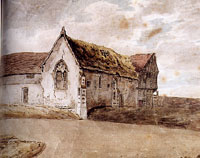 St Petronilla's Hospital
St Petronilla's Hospital |
This was located in Southgate Street, just outside the gate, and was demolished in the 19th century. Also spelled as St Petranilla's this stood near Domus Dei, with the original purpose of housing female lepers. By 14th century it took in lepers of both sexes, and then by the 15th century included helping the poor. It was well endowed, and was an important landlord.
According to Yates's Antiquities, second edition of 1843, it may have also been known as St Parnell's, as the head of this saint was one of the relics of the Monastery. Yates attributes the name Petronilla to Kirby. The window shown is the east window of the chapel. The chapel measured 44 feet by 18 feet inside. The projecting north windows belonged to the Refectory and Yates stated that "the massive timber of the ceiling of this room is still as sound as when first put up. It was valued at the Dissolution at £10. 7s. 1d clear value, and possessed temporals in Bury, Whepstead and Rushbrooke, and a portion in Mildenhall.
|
|
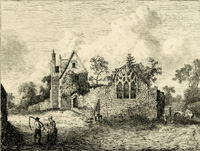 View of St Nicholas 1821
View of St Nicholas 1821 |
|
bla |
Although not published until 1843, I am reasonably happy that these comments were prepared by Yates for his original 1805 publication, and probably printed at that time, but omitted from the 1805 book.
Following St Petronilla's demolition, (some time after 1811), the chapel window was relocated to Eastgate Street, to the site of St Nicholas Hospital, where it is still visible on the Hollow Road, Eastgate Street and Barton Road junction. The relocation was undertaken by Philip Bennett of Rougham, who owned the site of St Nicholas' at the time.
This view was engraved and published in 1821, copyright of the Trustees of the British Museum, described as "View of a ruined chapel with a Gothic window in Bury St Edmund's. 1821 Etching". The print was made by Jacob George Strutt, and sold at Deck's shop on Angel Hill, Bury St Edmunds. It was one of a series entitled "Bury St Edmund's Illustrated in Twelve Etchings".
St Peter's Hospital, Out Risbygate Street
|
|
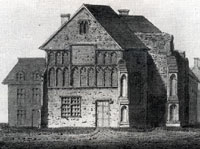 St Peters Hospital
St Peters Hospital |
This site is appropriately used today as a nursing home. However, St Peters was founded to become the official Leper Hospital for the Liberty of West Suffolk. It was founded by Abbot Anselm in the mid 12th century for leprous clerks, but it later welcomed the wider leper community. It became famous for its role in the plague epidemic of 1637.
- St Stephen's Hospital, Eastgate Street
This site is uncertain, except that it was located between Eastgate Bridge and St Nicholas's Hospital. Gillingwater wrote that it stood on the north side of Eastgate Street, and only a few fragments of wall remained in 1804. St Stephens or St Stephans was rarely documented and may well have collapsed from lack of funds in the 14th or 15th century. It may have been absorbed by the nearby larger and wealthier St Nicholas Hospital.
- St Nicholas's Hospital, Eastgate Street
|
|
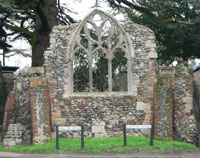 St Nicholas Hospital
St Nicholas Hospital |
The remains of the chapel were restored in the 19th century, but the conspicuous window seen at the junction with Hollow Road was moved there from St Petronella's (see above) as part of the restoration undertaken by Philip Bennett some time after 1811. St Nicholas's was founded in the 1250's by Abbot Hugh of Northwold, and as the saint was the patron saint of Lepers, it was probably originally for that purpose. No cure was available, and anyone found with leprosy was given a mass for the dead, and treated as so by society. They were sent to such hospitals to isolate them from infecting the rest of the community. This hospital was well endowed and extended its ministrations to other infectious diseases in later years. By the 13th century it also had its own almshouse. By 1340 it had 44 acres of land and was always one of the most financially independent hospitals. It was also popular with the townspeople.
Master Doctor Henry Rudde, who died in 1509 had a long association with this hospital.
- St John's Hospital, Southgate Street
This hospital was dedicated to St John the Evangelist and was better known as Maison Dieu or Domus Dei. It was founded in the 13th century, but the exact year is not clear. At least three dates have been suggested, ie 1216, 1248, and 1256. From 1300 to 1325 it was in financial disarray and had to be bailed out by the abbey. After this a large part of its income went to the Prior of the abbey and its Cellarer. Founded as an almshouse for seven destitute men, its position at the South Gate meant it was first port of call to many pilgrims reaching the town. It took in much money and started to care for ill pilgrims, possibly overstretching itself. By 1340 it had 12 acres of arable land at rent. In 1373 it received wealth from the Cockerel family to found a chantry.
|
St Botolph's - an enigma
|
|
- St Botolph's Chapel, Southgate Street
|
|
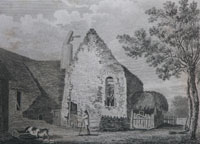 St Botolph's Chapel
St Botolph's Chapel |
Warren's maps of Bury showed the location of St Botolph's Chapel in 1747 and the revised edition of 1787.
In the 1843 edition of his Antiquities, Yates stated that the ruins of this old religious house stood in the yard of the White Hart Inn in Southgate Street. He wrote that it is now called the Chapel, and it is supposed to have been dedicated to St Botolph. Yates included it in his chapter on Hospitals, but its nature was unknown to him. In fact, Edmund Gillingwater recorded that it stood in 1801, but by 1804 it was wholly demolished and removed from the site.
The name St Botolphs Lane which runs to the rear of this site, does not appear to date back to the date of the original building. It was called Madame White's Lane until the 20th century, although Warren's map of 1748 shows the bridge over the Linnet as Botolph's Bridge. It appears to be part of Raingate Street at this time. Warren shows St Botolphs Chapel marked "I" on his map.
|
Post Monastic Hospitals of ancient origin
|
|
- Frenze's Hospital, Risbygate Street
This was a post monastic endowment by a priest, Sir John Frenze, made to the Guildhall Feoffees to found a leper hospital at the corner of Chalk Road and Risbygate Street. The Chalk Lane was soon called Spittle House Lane because of Frenze's Hospital, and the place itself was later referred to as the Spittle House. It was also useful as a general isolation hospital up to 1665.
- The Pest Houses, Sexton's Meadows
These were established in 1665, to take over the duties of isolating the infectious victims of any sort of plague or pestilence. As it happens, the plague virtually disappeared after the outbreaks in 1666.
|
The Schools
|
|
It would appear that even during the days of the abbey there was more than one school in Bury.
The schools might be described as follows:
- The Monastic School
This was within the abbey and was probably rather small with perhaps only 12 0r 13 students in the mid 13th century when there were about 80 monks. Its job was to produce Benedictine Monks for the monastery and from the 12th century probably had nothing to do with the town.
- The Grammar School
The origin of this school is confused and often mixed up in peoples minds with the Monastic School. They may have started out being one and the same, but there seems to be evidence of a separate Grammar School in the early to mid 12th century. For example Abbot Sampson himself had attended a secular school before seeking a Benedictine education.
In 1181 Abbot Samson endowed the school with a new stone building. This was located at the corner of Reyngate Street and Schoolhall Street, and was given a small landed endowment.
The Grammar School was also known as the collegiate school.
Samson also bought some stone houses so that the schoolmaster could live rent free and some income would be generated to support the poorer boys.
Its purpose was originally to train the secular priests, and perhaps later, in the 13th century, to educate the children of the more prominent townsfolk. By 1539 there were 40 free students, at least as many fee payers, the Headmaster, an usher and at least five sub masters.
- The Song School
The Scola Cantus seems to have been set up and financed by the Dusse Guild. It was to teach the singing of the Mass and Psalter to secular priests. Apparently it was in Songschool Street near the abbey. The abbey appears to have tried to set up its own songschool in 1290, but the Dusse Guild was strong enough to stop it.
Prepared for the St Edmundsbury website
by David Addy, August 1999
Books consulted:
English Medieval Monasteries 1066-1539, by Roy Midmer
Yesterdays Town - Bury St Edmunds by Margaret Statham
Bury St Edmunds and the urban crisis - by Robert Gottfried
An illustration of the Monastic History and Antiquities of the town and abbey of St Edmund's Bury - by the Reverend Richard Yates 1805
"Additions with 14 additional plates to the History and Antiquities of the abbey of St Edmund's Bury" - by the Reverend Richard Yates (Posthumous publication) 1843
|
|








